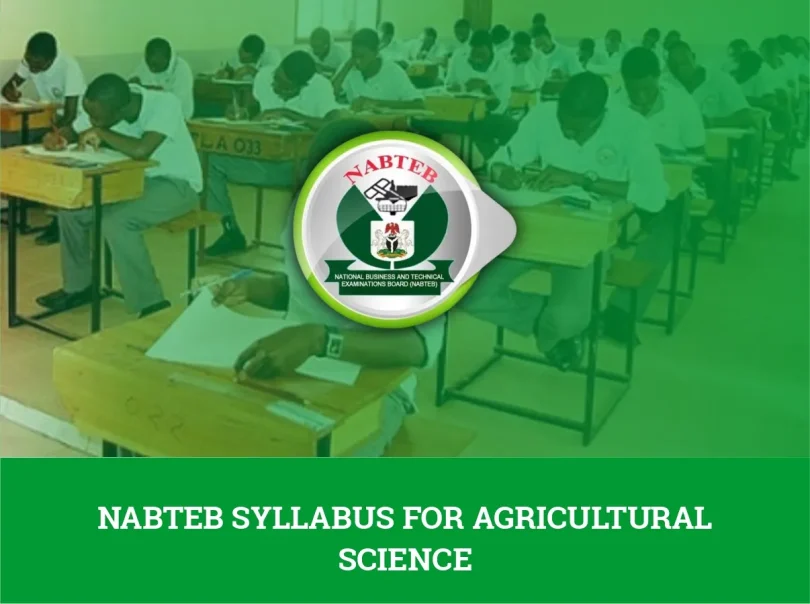Thinking about accessing the NABTEB Agricultural Science syllabus? The syllabus is thoughtfully broken down to build your knowledge about the subject. Through the syllabus, you will be introduced to the foundational pillars of agriculture, such as crop science. The NABTEB Syllabus for Agricultural Science sets students up for success in both exams and future agricultural ventures.
Whether you are a student preparing for exams or someone curious about how agriculture shapes our daily lives, this NABTEB Syllabus for Agricultural Science offers a clear path to understanding key concepts and building relevant skills. It is not just about memorizing facts; it is about developing the ability to solve problems, think critically, and apply knowledge to improve agricultural productivity.
Outline of the NABTEB Syllabus for Agricultural Science
Here is a clear and organized outline of the NABTEB Agricultural Science syllabus, broken down into its main sections and topics:
| Section | Topics Covered |
|---|---|
| 1. Basic Concepts / Introduction | Definitions of agriculture, importance, branches, and roles in national development |
| 2. Soil Science / Agricultural Ecology | Soil types, properties, fertility, conservation practices, and ecological factors affecting agriculture |
| 3. Agricultural Engineering & Mechanization | Farm tools and machinery, maintenance, irrigation, and drainage systems |
| 4. Crop Production | Crop classification, propagation methods, pest and disease control, harvesting, storage |
| 5. Forestry & Ornamental Plants | Basics of forestry management, planting, and care of ornamental plants |
| 6. Crop Protection | Weeds: definitions, types, damage, control methods (cultural, chemical, mechanical, biological) |
| 7. Animal Production / Husbandry | Types and classification of farm animals, breeding, nutrition, housing, and disease management |
| 8. Agroforestry & Fishery | Integrated farming systems, including trees and fish farming |
| 9. Agricultural Economics & Extension | Farm management, marketing principles, economics of production, and extension services |
Examination Structure & Aims
Aims:
Equip students with theoretical knowledge and practical skills; prepare them for further study or careers in agriculture; promote interest, resource awareness, and sustainable practices.
Exam Format:
- Paper I: Multiple-choice (Objective) + essays covering theory.
- Paper II: Practical component—hands-on tasks and specimen identification.
Recommended Textbooks for NABTEB Agricultural Science
Here are some highly recommended textbooks tailored for NABTEB Agricultural Science. These selections combine depth, clarity, and alignment with the syllabus to help you excel both in theory and practical applications:
- O.A. Iwena – Essential Agricultural Science for Senior Secondary School
- M.K. Komolafe & D.C. Toy – Agricultural Science for Senior Secondary School
- O.A. Akinsanmi – Senior Secondary Agricultural Science
- A.C. Anyanwu & B.D. Anyanwu – A Textbook of Agricultural Science for School & College
- Prescribed Agricultural Science for Senior Secondary School
Additional Recommended Reads (Great for Deeper Context or UTME Prep)
- Adeniyi et al. – Countdown to SSCE Agricultural Science and Anthonio et al. – General Agriculture for West Africa are excellent for supplementary reading and exam-focused revision.
- Egbuna et al. – Extension Modern Agricultural Science for Senior Secondary Schools, Emmanuel C. A. – A Dictionary of Agriculture, plus works by Falusi & Adeleye, Philips, and STAN offer richer context and superior coverage of specialist top.
Conclusion
The NABTEB syllabus for Agricultural Science is a practical and well-rounded guide designed to equip students with the essential knowledge and hands-on skills needed for success in agriculture.
Whether you are aiming for a career in farming, agribusiness, or further studies, this syllabus lays a strong foundation. With consistent study, the right textbooks, and a clear understanding of each topic, you will be well-prepared to excel in both the exams and real-world agricultural challenges.







Leave a Comment